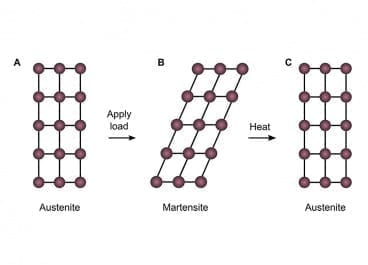
New materials developed at MIT could lead to actuators on a chip and self-deploying medical devices.
Ceramics are not known for their flexibility: they tend to crack under stress. But researchers from MIT and Singapore have just found a way around that problem — for very tiny objects, at least.
The team has developed a way of making minuscule ceramic objects that are not only flexible, but also have a “memory” for shape: When bent and then heated, they return to their original shapes. The surprising discovery is reported this week in the journal Science, in a paper by MIT graduate student Alan Lai, professor Christopher Schuh, and two collaborators in Singapore.
Shape-memory materials, which can bend and then snap back to their original configurations in response to a temperature change, have been known since the 1950s, explains Schuh, the Danae and Vasilis Salapatas Professor of Metallurgy and head of MIT’s Department of Materials Science and Engineering. “It’s been known in metals, and some polymers,” he says, “but not in ceramics.”
In principle, the molecular structure of ceramics should make shape memory possible, he says — but the materials’ brittleness and propensity for cracking has been a hurdle. “The concept has been there, but it’s never been realized,” Schuh says. “That’s why we were so excited.”
The key to shape-memory ceramics, it turns out, was thinking small.
The team accomplished this in two key ways. First, they created tiny ceramic objects, invisible to the naked eye: “When you make things small, they are more resistant to cracking,” Schuh says. Then, the researchers concentrated on making the individual crystal grains span the entire small-scale structure, removing the crystal-grain boundaries where cracks are most likely to occur.
Those tactics resulted in tiny samples of ceramic material — samples with deformability equivalent to about 7 percent of their size. “Most things can only deform about 1 percent,” Lai says, adding that normal ceramics can’t even bend that much without cracking.
David Dunand, a professor of materials science and engineering at Northwestern University, says the MIT team “achieved something that was widely considered impossible,” finding “a clever solution, based on fundamental materials-science principles, to the Achilles’ heel of ceramics and other brittle materials.”
“Usually if you bend a ceramic by 1 percent, it will shatter,” Schuh says. But these tiny filaments, with a diameter of just 1 micrometer — one millionth of a meter — can be bent by 7 to 8 percent repeatedly without any cracking, he says.
While a micrometer is pretty tiny by most standards, it’s actually not so small in the world of nanotechnology. “It’s large compared to a lot of what nanotech people work on,” Lai says. As such, these materials could be important tools for those developing micro- and nanodevices, such as for biomedical applications. For example, shape-memory ceramics could be used as microactuators to trigger actions within such devices — such as the release of drugs from tiny implants.
Compared to the materials currently used in microactuators, Schuh says, the strength of the ceramic would allow it to exert a stronger push in a microdevice. “Microactuation is something we think this might be very good for,” he says, because the ceramic material has “the ability to push things with a lot of force — the highest on record” for its size.
The Latest Bing News on:
Shape-memory ceramics
- A new manufacturing approach for heavy-duty ceramic membraneson April 30, 2024 at 9:00 pm
Membranes are widely used in a variety of industrial separation processes, but the polymeric materials that make up many membranes are not durable enough to handle extreme conditions, such as ...
- The 16 Best Oil Diffusers to Calm Your Mind And Zen Out, Tested & Reviewedon April 30, 2024 at 6:56 pm
Total relaxation is just one deep inhale of a luxury spa-like scent away.
- The 2024 PureWow Readers' Favorite Awardson April 30, 2024 at 10:01 am
PureWow Editors select every item that appears on this page,, and the company may earn compensation through affiliate links within the story You can learn more about that process here. Yahoo Inc. may ...
- Purdue researchers improve the plasticity of ceramic materials at room temperatureon April 29, 2024 at 6:09 am
WEST LAFAYETTE, Ind. — Researchers in Purdue University’s College of Engineering have developed and validated a patent-pending method that could expand the industrial applications of ceramics by ...
- Once-Popular Kitchen Tools People Stopped Usingon April 27, 2024 at 8:00 am
When it comes to cooking, there is no shortage of ways to do things easier, better, and faster. Here are some once-popular kitchen tools of yore.
- The 32 Best Wedding Gifts to Give or Receiveon April 23, 2024 at 12:53 pm
The best wedding gifts keep the lovely couple at the center. They're thoughtful and nice. Not too little, not too much. Classic registry items might include stuff for their homes— kitchen tools, fresh ...
- 59 practical yet thoughtful Mother’s Day gifts for the mom who has everythingon April 23, 2024 at 10:52 am
When it comes to giving a practical gift for Mother’s Day it’s important to find the sweet spot of items that are useful but also feel like a true gift.
- A Guide of American Museums to Visit This Yearon April 23, 2024 at 2:00 am
Siblings, parents and grandparents are collaborators and muses in a variety of upcoming shows around the country that highlight family traditions and bonds.
- The Moto Edge 50 Ultra revived the wooden phone, so can we get a Lego one next?on April 18, 2024 at 7:22 am
What is essential is invisible to the eye, but the Little Prince forgot to add something. Not every great phone out there is defined by its chipset, graphics processing unit, or its silky-smooth ...
- Event Almanac for April 18on April 18, 2024 at 4:00 am
April 21, 12 a.m., Crew up for the ultimate filmmaking project, April 19-21, and come make a movie in a weekend! That’s right…only 48 Hours! Challenge your creativity, collaborate with friends on a ...
The Latest Google Headlines on:
Shape-memory ceramics
[google_news title=”” keyword=”shape-memory ceramics” num_posts=”10″ blurb_length=”0″ show_thumb=”left”]
The Latest Bing News on:
Self-deploying medical devices
- A step forward for self-health monitoring—wireless charging through a magnetic connectionon April 30, 2024 at 9:43 am
Zheng Yan and a team of researchers at the University of Missouri have made a significant breakthrough in their ongoing development of an on-skin wearable bioelectronic device. Yan's lab, which ...
- Best Mobile Medical Alert Systems Of 2024on April 29, 2024 at 9:44 pm
Mobile medical alert devices come in various styles, including compact necklaces, bracelets and clip-on pendants. There are even smartwatch-style devices packed with convenient features.
- Medical Moment: The future of medical microbotson April 29, 2024 at 6:40 pm
(WNDU) - Robots have changed the medical field, and now, those robots are becoming smaller than ever before. They’re called microbots, also known as nanobots. They’re microscopic in scale, and ...
- Kenyan forces are about to land in Haiti — with nowhere clear to stayon April 29, 2024 at 1:03 pm
PROBING ISRAEL’S ACTIONS: A group of lawyers is calling on President JOE BIDEN to halt military aid to Israel, arguing that its actions in Gaza do not comply with U.S. and international humanitarian ...
- 5 Things to Know Before the Stock Market Openson April 29, 2024 at 4:29 am
US stock futures gain, Tesla closes in on deal to launch driver-assisted software in China, Paramount rises amid reports of possible CEO ouster, Philips shares soar as company agrees to $1.1 billion ...
- Top 5 Best QMS Software for Medical Devices in Canada for 2024on April 29, 2024 at 4:15 am
Quality Management Systems (QMS) are integral for medical device manufacturers as they ensure adherence to regulations and help in producing top-quality products. Utilizing the right QMS software ...
- Wall Street Breakfast Podcast: Philips Settles Ventilator Recall Lawsuitson April 29, 2024 at 3:47 am
Philips to pay $1B to settle US litigation over sleep apnea devices. Turkey in talks with Exxon over multibillion dollar LNG supply deal. Skydance makes 'best and final' offer for Paramount.
- Medical Devices Newson April 25, 2024 at 6:36 am
Ranked by W-2s issued by Bay Area offices in 2023 Showcase your company news with guaranteed exposure both in print and online Gather your employees for an afternoon of games as we honor the Best ...
- What to know about continuous glucose monitorson April 24, 2024 at 5:00 pm
A continuous glucose monitor (CGM) is a medical device that monitors blood glucose, or blood sugar, throughout the day. It works by measuring fluid glucose levels via a small implant. These ...
- Proven Insights for Efficient Medical Device Design & Developmenton April 24, 2024 at 5:00 pm
Related:Navigating Your Way to Success in the Medical Device Industry From the beginning, Dan emphasized the importance of collecting feedback from various stakeholders, not just physicians. For ...
The Latest Google Headlines on:
Self-deploying medical devices
[google_news title=”” keyword=”self-deploying medical devices” num_posts=”10″ blurb_length=”0″ show_thumb=”left”]










